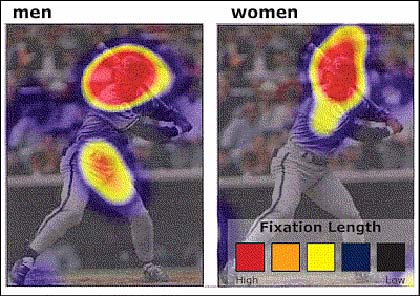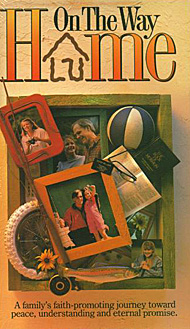Related to the post about eye-tracking for usability, you might be interested in eye tracking research that shows artists look at things differently.
Eye Tracking for Usability
Have you ever noticed how some websites are just easier to read than others? The New York Times comes to mind as a good example of a site that creates an enjoyable experience through its use of columns that are not too wide, tight writing, lots of white space, and jettisoning unnecessary imagery.
The Online Journalism Review recently ran an extremely interesting article about the science of good page layout. It explains how using eye tracking software, it is possible to create more efficient pages that help uses read pages faster and retain more information at the same time.

Among the different information that can be gleaned from eye tracking, I found the differences between the sexes eye moments to be the most interesting. (Though I will add, I’ve never found myself staring at other guy’s crotches — so that makes me wonder, is this for real?)

From the article:
Although both men and women look at the image of George Brett when directed to find out information about his sport and position, men tend to focus on private anatomy as well as the face. For the women, the face is the only place they viewed. Coyne adds that this difference doesn’t just occur with images of people. Men tend to fixate more on areas of private anatomy on animals as well, as evidenced when users were directed to browse the American Kennel Club site.
It would be interesting to delve a little deeper into this finding. If it is true, I imagine there may be some evolutionary reason for the differences.
(via Kottke)
Ze Meets Ray
Ze Frank finally met with Ray, the composer and singer of the internet meme, “Kick Somebody’s Ass”. This has got to be one of Ze’s most memorable shows to date.
McDonald’s Subliminal Advertising
With a wide spread of PVR adoption comes a new form of “subliminal advertising”. Ads that last only 1 frame (that’s 1/24th of a second) probably aren’t able to influence viewers even subliminally, however, the following McDonald’s ad works because it is noticeable enough that someone watching on TV might pause, rewind, see the ad and then talk about it or better yet, post it on YouTube and create an instant viral ad.
(via)
Subliminal Messages Psychology Materials
I occasionally get requests for materials for psychology classrooms based on the backmasking section of my website. I usually don’t send out materials, but I have been known to make exceptions, especially for professors of post secondary institutions.
I should point out that if you are teaching psychology, you may be interested in material intended for classroom demonstrations by writing John Vokey or Don Read at
Department of Psychology, University of Lethbridge, Lethbridge, Alberta T1K 3M4 Canadaand requesting University of Lethbridge, Department of Psychology, Technical Report No. 85. A blank cassette tape should be enclosed if classroom demonstrations are desired.
I imagine a blank CD would also work or maybe an empty USB thumb drive, but I would ask them first just to be safe.
Jay-Z and his Unconscious Influence
I came across a video clip of a preacher speaking out against the Hip Hop artist Jay-Z. Proponents of the evils of backmasking, like this preacher, argue that the effects of listening to music with backward messages are manifested in an unconscious manner on the listener’s subsequent behaviour.
He states that:
the heavy metal folks used to do that and they would put the backwards masked messages in your music and they’d say that your subconscious is smart enough—that right brain was smart enough to decode and flip that message so by the time it got to your left brain you understood it and you didn’t even know you understood it. You just acted it out. Because they have the song called Another One Bites the Dust — Queen. Played it backwards it said, I like to smoke marijuana. Yeah, and then they interviewed kids and kids say when they listen to it they just wanna get high, they just want to smoke weed and they had no idea that that message was being reversed in their mind and causing them to want to do that.”
I’d like to point out that contrary to this preacher’s claims, studies have shown that it is, in fact, impossible for the subconscious mind to “decode and flip that message”.
In volume 40, No. 11 of American Psychologist (November 1985), psychologist professors John R. Vokey and J. Don Read address the possibility of unconscious influence within reversed audio.
The proponents of backmasking argue that the effects of greatest concern are not the consciously perceived meanings of backward messages but rather those effects arising from unconscious or subliminal apprehension of the (forward) meaning of the material. Consequently, we also used tasks that required less in the way of conscious apprehension of meaning. We reasoned that if some subconscious mechanism existed for the interpretation of backward messages and their influence upon behaviour, then this mechanism should allow decisions to be made about content without necessarily revealing that content.
Their series of properly controlled scientific experiments included:
- Identifying whether a backward message when played forward was a statement or a question – 52.1% accuracy (50% expected on the basis of random assignment)
- whether they believed two sentences had the same meaning with only changes in the active or passive voice or whether the two sentences had different meanings — 44.81% accuracy (50% expected on the basis of random assignment)
- identifying a series of sentences into whether or not they would make sense if heard in the forward direction – 45.2% accuracy (50% expected on the basis of random assignment)
- categorizing statements of the sort, “Jesus loves me, this I know” into one of five content categories: nursery rhymes, Christian, satanic, pornographic, and advertising. 19.4% accuracy (20% expected on the basis of random assignment)
Upon the completion of their experiments Vokey and Read concluded, “we could find no evidence that our listeners were influenced, consciously or unconsciously, by the content of backward messages.”
I’m not one to deny that it does SOUND like Jay-Z has an anti-religious message in the reverse clip. It’s my belief that if such a message is intentional, its purpose is to gain publicity for his album. By pointing it out, this video has actually done a favour for Jay-Z. The prudent thing to do would be to ignore such obvious attention grabbing tactics. Nevertheless preachers like this one continue to disseminate the false claim that backwards messages within music can influence those listening. I think it’s because that message draws big crowds and allows the preachers to more easily sell copies of their sermons on DVDs.
[Jay-Z Subliminal Message – YouTube]
(Thanks Cody)
Stanford Prison Experiment
In 1971 Stanford University conducted a study of the psychology of imprisonment. While extremely unethical by today’s standards, this 50 minute documentary Quiet Rage: The Stanford Prison Experiment1 takes a fascinating look back at the incredible psychological experiment2. See also the Prison Experiment slide show with written history.
- Original Google Video has gone dark.[↩]
- The German movie Das Experiment is based on this event.[↩]
The Wizard of Oz and the Dark Side of the Moon
Fans of my backmasking page will probably want to check this out.
A few years ago my friend Megan dropped by the house sporting a copy of The Wizard of Oz in one hand, Pink Floyd’s Dark Side of the Moon in the other, and a giant grin on her face. We played them both simultaneously and watched/listened as the two synchronized. I am not completely sure it’s intentional, but there are some interesting coincidences.
I recall reading that when asked about this, Pink Floyd has neither admitted or denied intentionally creating their album to go along with The Wizard of Oz.
To set this up at home, you needed to start the album just as the MGM lion roared for the third time, but thanks to Google Video you can see the combined video and audio: Dark Side of the Rainbow.
It’s a little easier to make connections if you know the name of each track:
- “Speak to Me”
- “Breathe”
- “On the Run”
- “Time”/”Breathe (Reprise)”
- “The Great Gig in the Sky”
- “Money”
- “Us and Them”
- “Any Colour You Like”
- “Brain Damage”
- “Eclipse”
So what do you think, intentional syncronization or just our minds making connections where none exist?
Michael Mills Famous Backmasking Mp3
Back in 1981 a man by the name of Michael Mills created a radio show comprised of many backmasking clips purporting to show that rock music was influenced by satanic forces.
Thanks to the January 12th entry of the 365 days project you can listen to Michael Mills – Hidden & Satanic Messages In Rock Music (9MB mp3).
This 1981 Christian radio show (with host Michael Mills) exposes the threat of secret messages in your Rock and Roll! During the 45 minute radio show he covers a ton of artists… I’m playing 4 of my favourite segments on… Led Zeppelin, Kiss, The Beatles and Queen.
While I did find it interesting to listen to, I hope that you, the astute listener, will pick up on his lack of respect for the scientific process and see his motivation is fuelled by a preconceived hatred for rock music.
For example, not only is Mills sure to tell the listener what they are about to hear, before they have a chance to listen objectively themselves he also plays the backwards clips in such an order as to create a satanic message of his own arranging.
Near the end of the mp3 he shares the story of a young girl that complained that her room turned “an eerie and almost deathly cold” and claims that after she destroyed her KISS albums, the chills went away and we are left to assume the girl lived happily ever after. With his rearranging of backwards clips, his anecdotal evidence and his priming of the audience we know that what he presented is not scientific; clearly his agenda is that of closed minded fanatic.
Having said that, it is of course very entertaining — so enjoy, and be sure to get a permit before destroying your old records in a good old fashioned, satanic cleansing, barrel fire.
Update: Michael Mills and Beatles Forever.
Subliminal Messages in “On The Way Home”
I’ve always possessed a fascination with optical illusions, subliminal messages, the unconscious mind, and cognitive psychology in general. I think that’s why I found the idea of messages in music when played backwards so fascinating.
Back in 1998 I went on a mission for the LDS church. I was serving in the most unlikely place of Salt Lake City, Utah. Using the line, “we were just in the neighbourhood” seemed a little disingenuous when the temple marked the skyline behind you. There are a lot of Mormons there so we had to be a little more creative.
There are, however, a lot of people that are not members of the church. One of my favorite things about my mission was meeting people from all walks of life and from every imaginable social and economic backgrounds. The diversity of people I met ranged from those that were on the verge of being homeless, to literal billionaires.
Regardless of background, we (as missionaries) wanted to get our message out and influence people in as positive a fashion as we could. One of the methods of sharing our beliefs was the use of cheesy promotional videos that protreyed value of the family/church/good morals, etc.

One specific movie that I showed to investigators of the church was the movie, “On The Way Home”.
It’s a quaint little movie about a family who goes through the pain of the loss of their daughter/sister and meet some sister missionaries who teach them about God’s plan, The Plan of Salvation™.
The interesting thing about this movie is a rumour that I heard from another missionary about it containing subliminal messages. I was pretty sure it was just one of those missionary urban legends, because OBVIOUSLY the church wouldn’t buy into subliminal messages, not to mention the fact that even if they are “positive” messages, it sure leaves a bad taste in ones mouth to think I was being used as a pawn to subconsciously brainwash people. (Not me! I was there to help people.)
“What kind of subliminal messages?” I probed. The other missionary explained to me that near the start of the movie, when one of the main characters is jogging home for his baptism there is a bike race and someone watching the race holds up a big cardboard sign that says, “don’t do drugs” which flashes across the screen says the words, “don’t do drugs” but it’s muffled and hard to make out on a conscious level—unless you are specifically looking listening for it. So while that message didn’t seem like something you would expect, I still wasn’t convinced.
The message I remember him telling me about most was (and there may be more, but it’s this one that I remember) during the sister missionaries discussion, as they are teaching the family a lesson, the soft lighting and relaxing music which are in themselves creating a very serene and peaceful environment suddenly appear bubbles floating around behind them.
What?
“Bubbles? What? Why?” I couldn’t imagine that this was actually true. Surely I would have noticed bubbles. What would be the point of bubbles anyway?
Well the explanation went something along the lines of, “bubbles are supposed to induce feelings of peace and tranquility. They remind people of their youth and are relaxing. People subconsciously see the bubbles and it makes them feel good. When they feel good about your message they are more likely to act on it.”
I had to see it to believe it. I will always remember the next house I showed that video to. They were a super family that had just moved in to Utah and seemed quite interested in learning more about the church. As we sat there watching the movie I could hardly believe my eyes as tiny little bubbles started floating up in the background. I looked over at the others watching the movie intently. They didn’t notice.
They did however decide to get baptized. I wouldn’t try to say that the movie was the reason for it, I mean come on, bubbles? But nevertheless there you have it. Subliminal messages in “On The Way Home”.
Update (October 2022): I found a copy of the film on Youtube. I’ve updated the part about a sign that says don’t do drugs to reflect that it’s actually the sound of someone’s voice saying “don’t do drugs”. It’s hard to make out and one can’t ignore the power of suggestion when trying to decide what you hear. The sound happens at 18:29.
As for the bubbles, I do see something, but now I think it might have been dust floating around in the room where the film was shot. See 16:50.
There may not be anti-drug sound bites or calming bubbles intentionally placed to remove our agency, but the movie is manipulative. The grieving family is promised that if they join the church, follow the church’s rules including 10% of income for the rest of their life, they can see their dead daughter again. I hate admitting it but I can’t help but miss the message of hope it provides. Watching it now still gives me tingles—but it’s so manipulative!
